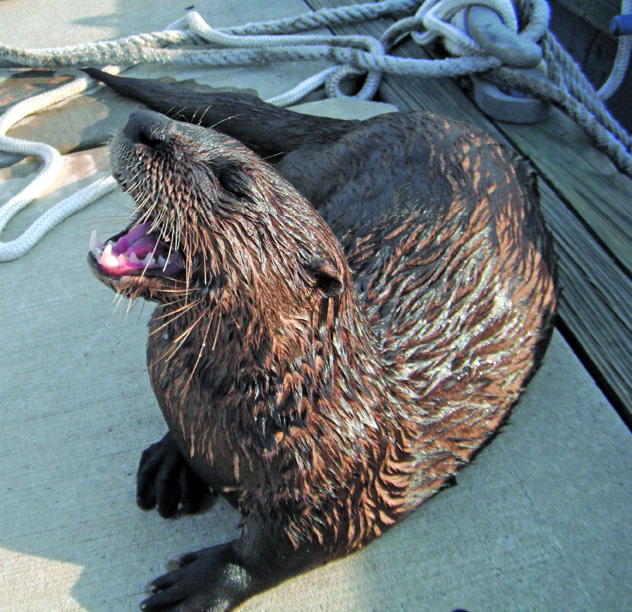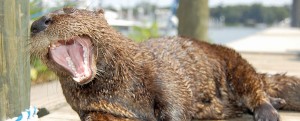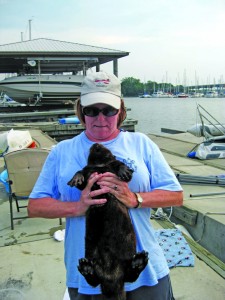Otto – an orphaned otter’s odyssey
Posted on August 6, 2013 By Editor Articles, Neighborhood News, Top Stories
Resident News reporter uncovers the end of the journey
“Chirp. Chirp. CHIRP!” It was March 2011 when Nick Sharrow of Jacksonville’s Sharrow Tree Service traced the disturbing high-pitched, penetrating distress call to an abandoned river otter pup in a client’s Riverside yard. “It was hard to ignore,” he said. The otter was so young its eyes only recently opened; he weighed about five pounds and was less than a foot long.
The next day, the otter was still there, more upset and no mamma otter in sight. Worse, it appeared to have a cold. Sharrow brought the otter home with him to his boat at Ortega’s “marina mile,” and dubbed the otter “Otto.” Sharrow bottle-fed Otto $5 cans of goat’s milk and tilapia. Upon recovery from his cold, Otto regained his energy and made himself at home in the marina.
In June, Sharrow tapped his new neighbor Roberta “Bertie” Weaver to take over Otto care as Sharrow’s work schedule and Otto’s exuberance conflicted. “Otto had it pretty good, with the tilapia and goat’s milk feeding!” joked Weaver, who became known along the marina mile as “Otter Mom.”
Weaver took to the role, tackling teaching Otto the basic skills he needed to survive in the wild. She and another neighbor, Patty Hamilton, began fishing locally for Otto’s food. She introduced him to the water with a baby pool, and then took him to Redneck Beach where he learned to swim. She also gradually cured him of his fear of rain. By August, Otto learned to catch his own fish, and often disappeared for days at a time with his girlfriend, a wild river otter.
Meanwhile, Otto’s playful, mischievous nature both charmed and distressed the neighbors.
John Light introduced himself to Weaver after seeing Otto romp in neighborhood swimming pools from his upper story condo windows. “What the heck is that?” Light asked Weaver.
“It was hard to imagine that wild otter didn’t know who his mamma was. He didn’t get that he was an otter. He just figured he was part of the family,” Light observed. “Everyone looked out for him.”
A nearby office worker, Jane Smith, became concerned when she saw Otto conk himself on his head. Smith asked a friend who was a volunteer with an animal rescue and rehabilitation “rehabber” agency what to do if Otto needed medical care. Smith’s friend became alarmed, insisting Smith contact the wildlife authorities, requesting they capture and remove the otter. Smith refused. However shortly after, she believes her now former friend contacted at least one local wildlife agency.
Smith admits she didn’t want to see Otto suffer the same fate the stray cats fed by office coworkers did. They were hit and killed by cars, which often speed along Lakeside Drive. Smith was contacted when another friend found Otto wandering on Euclid near San Juan Avenue. She returned him to “his” marina.
Around that time, Weaver recalls a visit from a representative of the Wildlife Rescue Coalition of Northeast Florida. When told the visit was to check out an otter, Weaver offered to call Otto. “Oh no!” she remembers the wildlife representative responding. “They’re vicious!”
That visit was followed by another from Florida Fish and Wildlife Commission (FWC) inspector Kevin Larsen, spurred by complaints placed between Jul. 28 and Aug. 11, 2011 that “there was an otter held captive on a boat in a marina,” requesting it be turned over to a wildlife rehabber.
When Larsen met with Weaver, she pointed out Otto to him. Otto, a bit of a ham, hopped up out of the river onto the marina dock, and mugged for Larsen’s camera. Larsen snapped Otto’s photo, but took no further action.
Later that fall, on a mid-November morning, Weaver noticed Otto’s telltale footprints ended where a set of car tread marks began. She suspected Otto was gone for good.
November 12, 2011, Otto was admitted to the Wildlife Rescue Coalition of Northeast Florida, according to its founder and president, Barbara Tidwell. The next day they placed Otto with a licensed wildlife rehabber.
Meanwhile, Weaver and several neighbors initially thought Otto returned when they spotted an otter around the marina over the next few weeks. They realized, however, it was a little smaller than Otto, who’d reached about 25-30 pounds by then. Weaver figured out the otter was Otto’s girlfriend, trying vainly to find him.
Weaver and Otto’s other marina mile friends missed Otto. They had visions of his returning to the wild eventually, becoming a father, watching baby wild otters become part of the marina mile wildlife. They hoped wherever he was, that would still happen.
It was Sharrow’s search for new companionship in a different form that revealed Otto’s whereabouts. Ironically, on the “Plenty of Fish” dating website, Sharrow’s photo of Otto was recognized by a volunteer wildlife rehab assistant, Dawn Fox. She contacted Sharrow and told him Otto was in the “care” of a longtime licensed rehabber, Leslie Straub. Fox, a former volunteer with Straub, was so upset about the crowded and inhumane animal’s conditions at Straub’s, she reported her to the Florida Fish and Wildlife Conservation Commission. Fox even shot and released a series of disturbing videos of Straub’s home, where she was keeping wildlife piled in closed boxes.
Otto’s former caretakers were outraged, incited by Fox’s video and photos of Otto’s small cage, and his filthy swimming pool. When they also discovered he was now neutered, it became clear to them it was unlikely Otto would ever return to the wild. Even when Straub was convicted, her license suspended and all the surviving animals in her care relocated, they feared Otto would be returned to Straub eventually or suffer elsewhere in poor conditions.
Weaver contacted Busch Gardens to see if Otto was located, if they’d take him in. Busch Gardens was potentially willing, but Otto’s whereabouts were still unknown.
Following the trail of Otto’s
disappearance for this story led to re-contacting the FWC. Karen Parker, FWC’s Public Affairs Officer revealed Otto, since renamed Walle, is now living happily at Clearwater Marine Aquarium. He’s even become buddies with Cooper, another otter at the Aquarium.
Michael Atwell, Marketing and Public Relations Manager for Clearwater Marine Aquarium confirmed Walle’s residence. Walle is also featured on their website, www.seewinter.com.
Weaver was delighted to tell Sharrow about Otto’s new home on Sharrow’s birthday. “That’s the best birthday present, ever,” he replied, misty-eyed.
Weaver, Sharrow, and Light are planning a trip to Clearwater soon. They can hardly wait to see Otto again, though they want to make sure they don’t do anything to disturb Otto’s contentment with his new home. “Now we’ll never have to worry about a local ‘gator getting Otto, or that he’ll be hit by a car,” says Light, happily.

It’s clear Otto lives on in the hearts of the village of marina mile that raised him; their faces light up with joy as they share the stories of his antics, show their smart phone Otto videos and photos, and point to the Otto Sharrow Facebook page.
Still, if Sharrow or Weaver were to find an abandoned wild animal today, they would contact a wildlife rehabilitation agency.
Parker emphasizes “It’s usually the wildlife that suffers when they come in contact with people. In Otto’s case, he’d lost his fear of people. That would make it difficult for him to return successfully to the wild.”
“It’s true. Otters are social, playful creatures; Otto loved everyone he met,” concludes Hamilton.
Contributed By
Dana Greyson




 (No Ratings Yet)
(No Ratings Yet)






